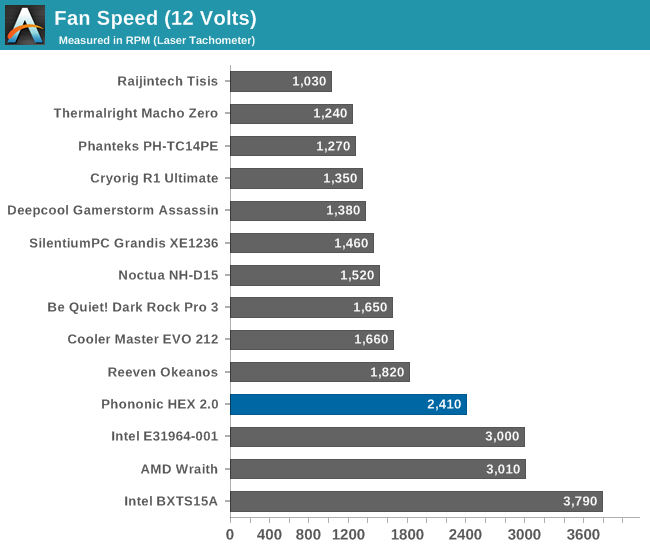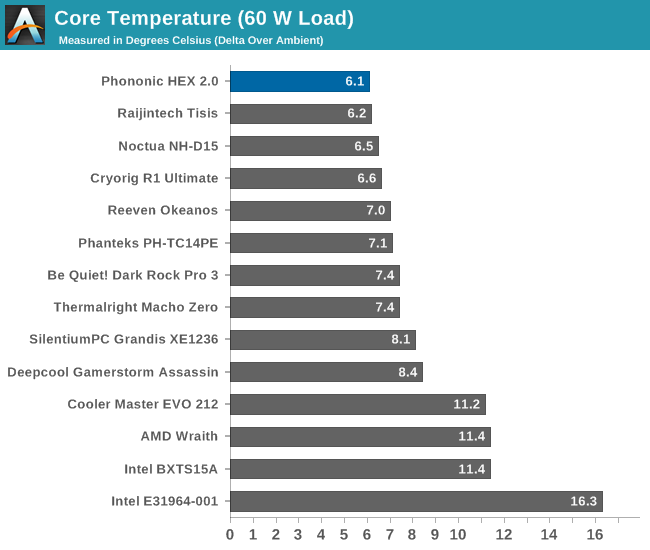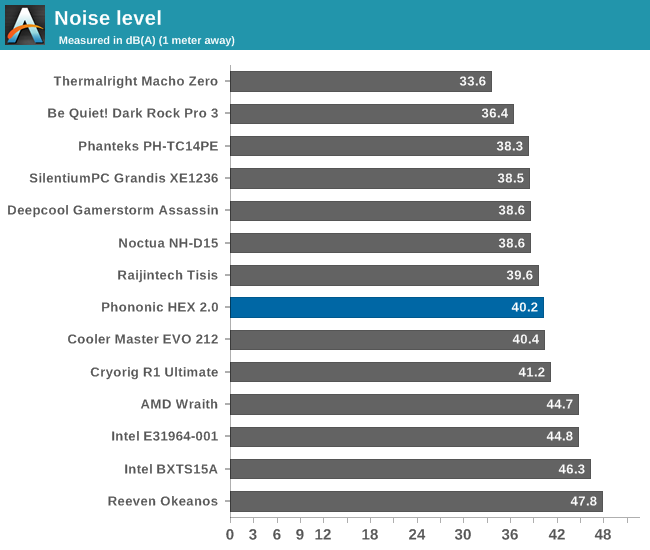The Phononic HEX 2.0 TEC CPU Cooler Review
by E. Fylladitakis on September 26, 2016 9:30 AM EST- Posted in
- Cases/Cooling/PSUs
- Cooler
- TEC
- Phononic
- HEX 2.0
Testing results, maximum fan speed (12 Volts)
The thermal performance of the Phononic HEX 2.0 is a relatively complicated topic. Most typical coolers have a relatively steady absolute thermal resistance regardless of the load or, depending on the cooler’s mass, the absolute thermal resistance slightly decreases as the temperature difference increases. The HEX 2.0 shows the completely opposite behavior; it’s absolute thermal resistance is very high at lower loads but it sharply degrades at higher loads. This happens because, in layman’s terms, the TEC cannot cope with the excessive thermal energy while, at the same time, it inserts its own thermal losses into the system, leaving the relatively small tower cooler to cope with much more than just the chip it is supposed to be cooling.


| Core Temperature, Constant Thermal Load (Max Fan Speed) |
The average thermal resistance of the HEX 2.0 is 0.1459 °C/W, which seems to be poor considering the target audience of this cooler. However, the thermal resistance of the cooler with a low thermal load of 60W is 0.1017 °C/W, easily rivaling the largest of tower coolers and even liquid cooling solutions. As the load increases, the thermal resistance of the HEX 2.0 decreases, particularly with thermal loads above 200W. With a thermal load of 340W, the thermal resistance of the HEX 2.0 drops down to 0.1685 °C/W, hardly competing with the performance of budget-oriented and stock coolers.

As for the energy consumption, the HEX 2.0 will almost entirely disable the TEC for thermal loads below 20W to minimize consumption and will prevent condensation issues. It will not push the chip to temperatures below the ambient in its balanced mode. If set to the insane mode, the TEC will always operate at maximum mode and could possibly get the CPU to register temperatures below the ambient, but only if the thermal load is very low.

Aside from it turning the TEC off completely, the TEC controller virtually has two operation modes; half power and full power. The controller decides when to set each mode depending on the thermal load and the ambient temperature. Roughly, the TEC shuts down for a thermal load below 15W, it operates at half-power mode for a thermal load between 15W and 90W, and goes at full-power mode for a thermal load above 90W. The TEC itself consumes about 20W at half power mode and 40W at full power mode, with the exact value slightly varying depending on the temperature. Note that a large percentage of this energy consumption is inserted as additional thermal load for the cooler to dissipate.










48 Comments
View All Comments
DanNeely - Monday, September 26, 2016 - link
Do they have an plans to make a 120/140mm version and a larger TEC? The way this struggles above relatively low loads makes it a bust for the OC crowd who might otherwise be tempted to buy it.zepi - Monday, September 26, 2016 - link
Indeed, would be interesting to see this being bundled with NH-D15 level cooler.LordConrad - Tuesday, September 27, 2016 - link
I would also like to see the TEC with a better air cooler attached.saratoga4 - Monday, September 26, 2016 - link
Or one integrated into a watercooling setup. The main problem is that the TEC COP of performance is something like 1.0 to 1.5 watt of cooling per 1 watt of energy spent on the TEC, so you end up needing 1.5-2.0 watts of radiator for every watt of CPU heat generated. A dual 120 radiator ought to handle that easily.MrSpadge - Tuesday, September 27, 2016 - link
Chilled water with a phase change (refrigerator) cooler is way more efficient.JesseKramer - Wednesday, September 28, 2016 - link
Packaging would be more of an issue though I would think.There is lots of infrastructure set up around radiators inside cases.
Adding a TEC into an AIO could be a very interesting product
Lolimaster - Monday, September 26, 2016 - link
Nothing beast using air cooler and undervolting your cpu and maybe drop 100-300Mhz to maximize the gain. Do you really notice the tiny extra performance of OC while wasting tons of watts and heat?damianrobertjones - Monday, September 26, 2016 - link
Yes! I, as a child, often heard scary stories of the 'Nothing Beast'!AndrewJacksonZA - Monday, September 26, 2016 - link
*chuckle*Death666Angel - Tuesday, September 27, 2016 - link
I do. Running my 4770k @ ~3.4GHz like you suggest vs. the 4.5GHz it currently runs at would not save much energy on normal tasks (I OC with an adaptive offset, so 800MHz use ~ 0.71V). Even in many modern games (The Witcher 3, Battlefield 4), I would get lower FPS with such a CPU clock and my R9 290X, which is more CPU dependant than typical Nvidia graphics cards. And doing video encoding of my Blu Ray rips would be painfully slow, scaling nearly linearly with clockspeed. The ~50 to 90W I spend more on intensive tasks is worth it for me, since I can saturate 110FPS with my monitor @ 110Hz and save time during encoding (which make total power consumption per rip not as bad as it would seem).